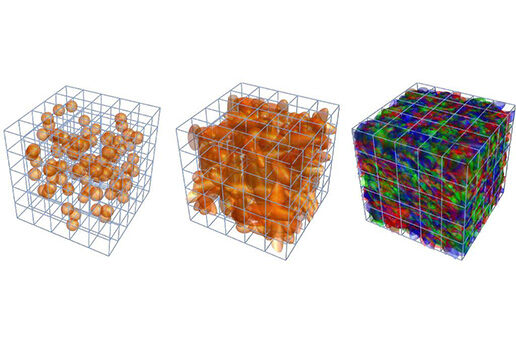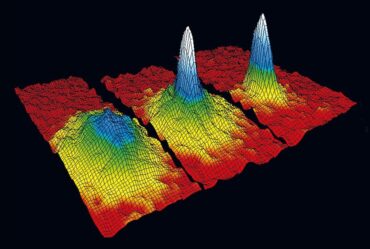
MIT researchers use Frontier to model the density, pressure inside neutron stars
For astrophysicists, neutron stars stand out as objects of irresistible fascination — perhaps, in part, because of how difficult they are to decipher. But calculations conducted on the Frontier supercomputer, located at the Department of Energy’s Oak Ridge National Laboratory, have revealed new clues about the inner workings of neutron stars. Frontier’s exascale-class computing power — capable of a quintillion or more calculations per second — enabled the team to study particle systems of unprecedented size.
Formed after a massive star’s core collapses, and the star’s subsequent supernova explosion, neutron stars are the densest objects in space that can be directly observed. That density also makes them impossible to replicate in a lab. In fact, two cubic centimeters of neutron-star matter would weigh as much as every human on Earth combined. And, given that the closest neutron star is about 400 light years away, their distance limits the ability of astrophysicists to observe much about their properties via telescope. So, to understand the extreme conditions within neutron stars, physicists must turn to computer models to predict behaviors that can hopefully someday be confirmed through observation.
A major unknown about neutron stars is their equation of state — in other words, how changing their density or temperature affects the pressure inside the star. Knowing this equation of state, scientists could estimate how massive a neutron star can become, because that maximum mass is determined by the tug of war between gravity and pressure. This thermodynamic equation can also reveal much about the subatomic composition of such far-off stellar objects.
A team of researchers from the Massachusetts Institute of Technology used Frontier — managed by the Oak Ridge Leadership Computing Facility, a DOE Office of Science user facility at ORNL — to chart the isospin density of a neutron star over a range of conditions. Their findings, published in Physical Review Letters, provide important predictions for how pressure and density interact within neutron stars.
“Neutron stars are superdense environments, about which we know some things but not very much. It’s not a form of matter that we can create in laboratories and test, but it’s something we can try and make theoretical predictions about,” said William Detmold, principal investigator for the project and a professor in MIT’s Department of Physics. “And that’s really what my ultimate goal is — to understand from the underlying theory what that matter is like and what kind of observable consequences it will have for neutron stars.”
Neutrons and protons have equal but opposite isospin, a quantum number that describes how many up and down quarks make up each particle. Most stars usually have a nearly equal number of neutrons and protons, so their isospin density is almost zero. But because neutron stars have abundant neutrons, they have a nonzero isospin density. This is important for understanding the properties of the matter within the star. By predicting how the protons’ and neutrons’ constituent parts (quarks and gluons) interact as the density and pressure increase, a star’s equation of state can be better characterized.
“What we basically did in this project was calculate how changing the isospin density affects the matter that we see. For the first time, we have been able to map out how the pressure changes as you change this density. We now really have the equation of state mapped out across this entire density axis,” Detmold said.
One of the most challenging goals for researchers in nuclear and particle physics is better understanding the interactions between quarks and gluons — the building blocks of protons and neutrons, which make up atomic nuclei. The theory of the strong nuclear force that forms the bonds between these particles is called quantum chromodynamics, or QCD. Making predictions based on QCD requires high-performance computing to solve its complicated mathematical equations. Computational physicists use an approach called lattice QCD, which defines quarks and gluons on a 4D space-time grid. The MIT team’s grids are some of the largest for lattice QCD calculations.
“Key components of these lattice QCD calculations are called quark propagators, which encode the probabilities of quarks moving from one place to another. If you were to write these out as entries in a matrix, the matrices would be something like 10 to the 10th by 10 to the 10th, which is very large. The algorithms for doing these inversions require a lot of memory but also need to do a lot of floating-point operations,” Detmold said. “Frontier is particularly good for this because its GPUs provide a very high level of floating-point performance through lower-precision arithmetic. Working with these matrices would not have been feasible on prior systems.”
The scale provided by systems such as Frontier is pretty much a necessity to do calculations like this, both in terms of parallel computational capacity and storage. It would take many millennia to run this calculation on, say, a laptop.
Ryan Abbott, a doctoral student at MIT
The isospin density projections produced by the MIT team involved a multistage process that started with about eight months of near-continuous computing on Frontier. First, it ran lattice QCD calculations using the Chroma software package and QUDA library to generate snapshots of the quark and gluon configurations. The resulting matrices were then inverted and combined using a new algorithm created for this project by the MIT team. The algorithm converts the matrices into smaller sparse versions for easier analysis.
“The new algorithm that we developed lets us analyze them without having to generate new samples every time,” Detmold said. “We can basically use the same set of samples and change the quantity we’re trying to calculate on them. So, we can access the system at different densities and just change the density almost as much as we want. That’s the biggest innovation specific to this particular problem, which we made for this calculation.”
Executing these inversions required Frontier’s exascale computing power, which can exceed a quintillion calculations per second.
“The scale provided by systems such as Frontier is pretty much a necessity to do calculations like this, both in terms of parallel computational capacity and storage. It would take many millennia to run this calculation on, say, a laptop,” said Ryan Abbott, a fifth-year doctoral student at MIT who conducted much of the data analysis on the project. “The systems we studied are certainly the largest number of particles in any lattice QCD calculation. Most lattice calculations study at most three or four particles, whereas we’re working with thousands.”
The findings made by the MIT team will help create a fuller picture of neutron stars’ equation of state, helping astrophysicists make informed projections about what’s going on inside these distant stars.
“One of the key questions here is whether there’s quark matter inside neutron stars. Really, to answer that, you’re never going to have a probe that goes inside the neutron star and tests it. So, you’re going to have to make predictions for what happens if there is that matter, or if there isn’t, and confront them with experiment,” Detmold said.
“Science never really deals with certainties. You come up with a theory, and you can constrain it from experiment, but you really learn only what you can learn from the data that you have,” he added. “There’s always going to be some kind of ambiguity, and it’s really a matter of how much you can push down on that ambiguity to really understand what’s going on at the fundamental level.”
UT-Battelle manages ORNL for DOE’s Office of Science, the single largest supporter of basic research in the physical sciences in the United States. DOE’s Office of Science is working to address some of the most pressing challenges of our time. For more information, visit energy.gov/science.
— Coury Turczyn
Media Contact
Coury Turczyn, Science Writer, 865.341.0352 | turczyncz@ornl.gov


